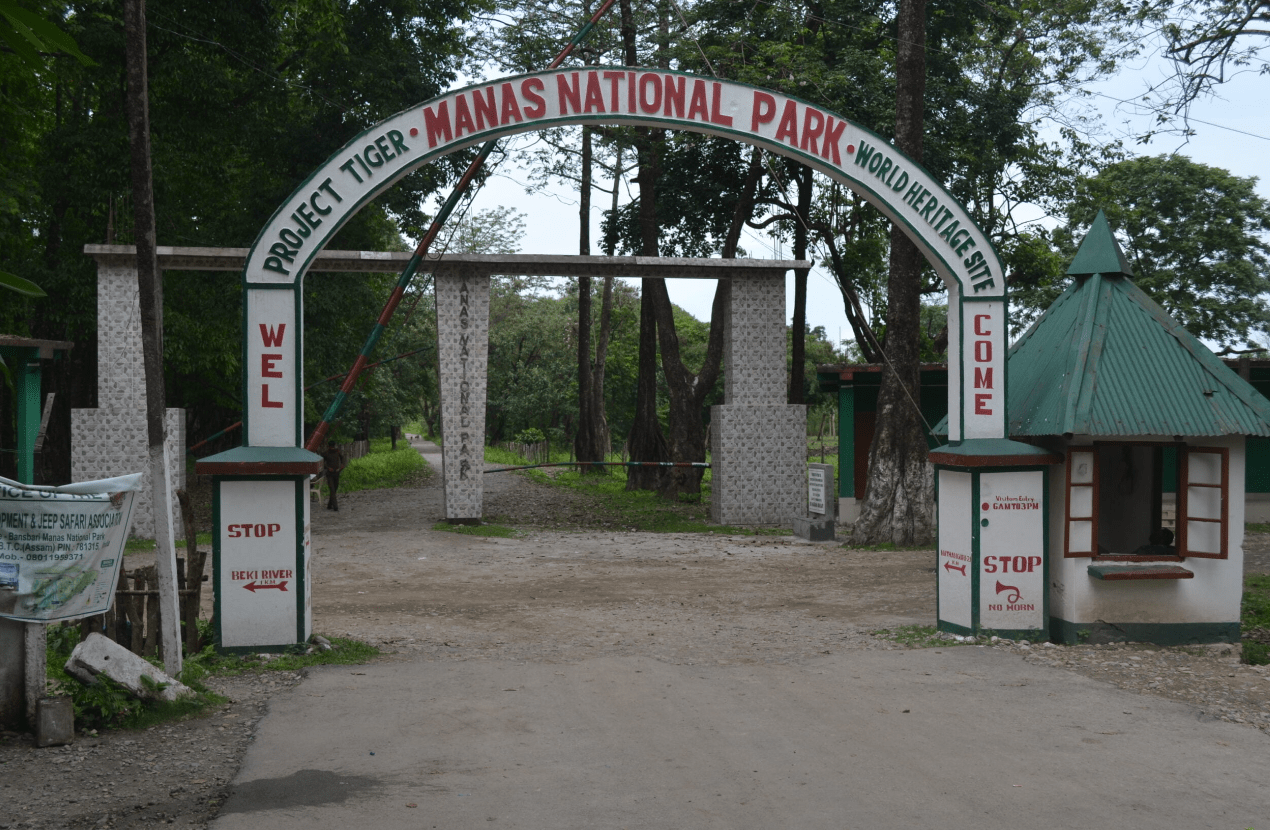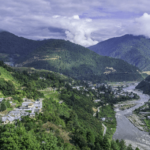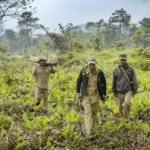We arrived, explored, and fell in love. That’s how we felt about Bodoland. This place, with its breathtaking landscapes, wildlife sanctuaries, and welcoming people, truly captured our hearts. The week we spent in Bodoland during the Dwijing Festival was filled with pure joy and excitement. We uncovered the “untouched land,” experienced a vibrant festival in Northeast India, embarked on the longest safari of my life at Manas National Park, and met incredible people along the way. The cherry on top was being there as the “Ambassadors of Bodoland,” helping to put this beautiful region on the tourism map. So sit back and let the 2 Backpackers take you on a journey through the wonders of Bodoland.
Is Bodoland Safe to Travel?
Not long ago, the mention of ‘Bodoland’ was met with skepticism due to its past. It wasn’t considered a ‘safe’ travel destination. When I told my family I was headed to Bodoland, they looked at me like I was crazy.
But those fears and doubts are now a thing of the past.
Bodoland is absolutely safe to visit. Period. The entire northeast is, too.
As a solo female traveler, I can confidently say there are few places in the country safer than these areas. This realization came after extensive travels in Northeast India, both solo and with Agni. So let go of your doubts, keep an open mind, and come explore Bodoland.
Where is Bodoland?
Bodoland is the homeland of the Bodos, an indigenous group in Assam. Nestled in the foothills of the Bhutan Himalayas, Bodoland comprises four districts of Assam. The region is now known as BTAD (Bodoland Territorial Area Districts), governed by the BTC (Bodoland Territorial Council), which holds legislative, administrative, executive, and financial powers.
We visited the Bongaigaon and Chirang areas for the Dwijing Festival and also explored Manas National Park in the Baksa region. Kokrajhar and Udalguri districts are also part of BTAD.
What Does Bodoland Offer to Tourists?
Bodoland is a treasure trove of biodiversity, featuring important wildlife sanctuaries and reserves. Manas National Park is one of Assam’s most significant wildlife sanctuaries. Beyond its rich flora and fauna, the area is culturally vibrant. It is the heartland of the Bodos, Assam’s largest ethnic group. The locals fiercely preserve their traditions and culture, and they’ll warmly welcome you, inviting you to experience Bodo culture and hospitality.
Despite its cultural and natural richness, the region has remained under the radar, mostly due to minimal promotion and negative publicity. But with the support of Bodoland Tourism and the efforts of the Ambassadors of Bodoland, the region is bound to gain its rightful place on the tourism map.
What Are the Must-Visit Places in Bodoland?
Manas National Park is undoubtedly the region’s most iconic attraction, but Bodoland has much more to offer than just wildlife. Here are some must-visit spots:
Manas National Park
As previously mentioned, Manas National Park is the most famous and well-developed attraction in Bodoland. Manas is unique in many ways. It is the only national park in India with five conservation statuses: it is a UNESCO World Heritage site, a Project Tiger Reserve, an Elephant Reserve, an Important Bird Area, and a Biosphere Reserve. It’s also the only forest area that has expanded in size!
In 1992, UNESCO declared Manas National Park a World Heritage site in danger due to heavy poaching, deforestation, and other illegal activities. However, thanks to the conservation efforts of the locals, Manas was eventually removed from the list of World Heritage Sites in Danger. You can learn more about these efforts in our post about MMES.
A Walk with the Elephants
We stayed at the Smiling Tusker Elephant Camp in Manas, where the camp had adopted two orphan elephants named Jaymala and Ratnamala. One afternoon, we joined them for a walk along the tea gardens. But first, the elephants were treated to a bath in a nearby stream, where some of us helped scrub them with grass. It was heartwarming to see Jaymala and Ratnamala enjoying their bath and playfully spraying water on everyone around them.
After their bath, the elephants led us on a walk through the tea gardens and village roads. They would occasionally stop for a quick snack, breaking branches along the way—evidently hungry after their bath! With the golden light of the setting sun, the entire scene took on a dreamy quality, and the photographers among us busily captured the perfect golden-hour shots.
Later, we strolled through Bodo villages on the fringes of the forest, where we were warmly welcomed by the locals. We took photographs, and in return, we received nothing but friendly smiles. Who says Bodos aren’t hospitable?
A 7-Hour Safari
Our longest safari yet was worth every minute. The ride was bumpy, and we were covered in dust, but our quest to witness the flora and fauna of Manas National Park kept us going. We spotted several animals and drove through lush forests until the scenery suddenly changed, revealing the Manas River. We stopped by the riverbank to enjoy the serene view.
The Manas River, which originates from the gorges of Bhutan, flows through the national park. The clear blue waters of the river contrasted beautifully with the white pebbles on the bank, while the green mountains in the background provided a perfect setting for photos and videos. I stood quietly, mesmerized by the sudden change in the landscape.
We also visited the Bhutan border, where the Bhutanese side of the sanctuary is known as the Royal Manas National Park. The safari was a success, as we spotted elephants, rhinos, deer, Himalayan giant squirrels, water buffaloes, and various birds. Although we didn’t see any tigers, we did spot their paw prints, which left us hopeful. Our guide mentioned that he had seen a tiger just a few days earlier, but we had to settle for the paw prints alone.
When We Almost Got Trampled by an Elephant
Elephants are wonderful, but only when they are domesticated or at a safe distance. Perhaps we were emboldened by our earlier encounter with Jaymala and Ratnamala, but during the safari, we spotted a wild elephant with her calf standing peacefully. We took some pictures from a distance, but for some reason, everyone in our jeep decided to get closer. We disembarked and approached the elephants. Niharika, a fellow blogger, was busy capturing the scene with her camera when, suddenly, the mother elephant charged at us with a loud trumpet. There was only a thin fence between us and the elephant, which could have easily been trampled.
And we ran. We ran like never before—for our lives!
A few locals managed to calm the elephant with shouts, and thankfully, the elephant either heeded their calls or showed mercy. Whatever the reason, we were grateful for such a close encounter with a wild elephant! It also taught me never to get too close to any wild animal again.
Those few seconds were both terrifying and unforgettable. Interestingly, Niharika kept her camera rolling, capturing shaky footage of the incident, complete with our screams and the sound of us running.
Enjoying a Cultural Evening
In the evening, we were treated to a surprise—a Bihu dance performance by the local villagers. The Assamese songs have a melodious and catchy rhythm that makes you want to tap your feet. Everyone present attempted the Bihu dance, although I’m not sure what exactly we were doing—but at least we tried!
What Is the Cost of a Safari at Manas National Park?
At Manas National Park, you can choose between an elephant safari and a jeep safari. The elephant safari takes place early in the morning around 6:30–7:00 AM, with rates set at INR 500 for Indians and INR 1,500 for foreigners.
Jeep safaris are available in the morning (from 9:00 AM) and afternoon (from 2:00 PM) for either half-day or full-day tours. The entry fee is INR 100 for Indians and INR 500 for foreign nationals. The cost of a jeep safari is INR 2,000 for a half-day and INR 4,000 for a full day.
A Visit to MMES at Baksa
If you’re visiting Manas National Park, you should also stop by the Manas Maozigendri Ecotourism Society (MMES). This society is largely responsible for wildlife conservation in the area. Former poachers, who once earned Manas a “danger” tag, have now turned into fierce protectors of the forest and its wildlife. You can learn more about MMES in our previous post.
The Bhutan border at Nganglam is also nearby, and the drive there is pleasant. Nganglam is known for its large cement factory. You can enter Bhutan by obtaining a permit at the checkpost. With the right permit, this could be an additional entry point to Bhutan, besides Phuentsholing.
Kalamati
Kalamati, meaning ‘black soil,’ is located in the Chirang district and is part of the Manas Reserve Forest and a buffer zone of Manas National Park. The area features a unique landscape that extends to the Bhutan hills. The Kanamakra River flows through the valley near the Indo-Bhutan border. Interestingly, Kanamakra means ‘blind spider,’ though the origin of the name is unclear.
Kalamati is a meeting point for wildlife, as animals come here to lick the salt-rich black soil. Although it remains underdeveloped
, Kalamati is a significant tourist attraction with the potential to become a popular destination.
On a clear day, you can see the snow-capped Bhutan hills in the background. The view alone is worth the trip. The surrounding landscape is equally beautiful, with lush greenery and tall trees.
From Kalamati, a road leads to Panbang in Bhutan, which we intended to explore. Unfortunately, our guide informed us that a landslide had blocked the road. Had we known earlier, we might have planned our trip differently. If you’re planning to visit, be sure to inquire about road conditions in advance.
Bogamati
Located 45 km from Baksa and 92 km from Guwahati, Bogamati is a popular picnic spot on the banks of the Bornadi River. The river originates in the hills of Bhutan and flows down to the plains, with white pebbles covering the riverbank. The name Bogamati means ‘white sand.’ The area is surrounded by dense forests, making it an ideal place for camping.
On weekends and holidays, Bogamati is a favorite picnic spot for locals. There are a few eateries and lodges nearby if you plan to stay overnight.
Dwijing Festival
The Dwijing Festival is a well-known festival in the Bongaigaon district of Assam. ‘Dwijing’ means ‘riverside.’ The festival is held every year from the last week of December to the first week of January on the banks of the Aie River, a tributary of the Brahmaputra. Originally known as the ‘Aie River Festival,’ it was renamed Dwijing in 2016.
Dwijing Festival, a joint initiative of the Assam Tourism Department and Bodoland Tourism, showcases the colorful culture of Assam and Bodoland. The festival includes cultural performances, adventure activities, food stalls, and exhibitions. It provides a platform for local artists and entrepreneurs to display their talents and products.
The Dwijing Festival has grown over the years and now attracts visitors from across the country and even internationally. Although primarily a cultural festival, the event also includes adventure sports such as parasailing and hot air balloon rides. You can enjoy local cuisine and shop for handicrafts, handlooms, and organic products at the stalls. There are also boat races, cycle races, and traditional sports competitions.


